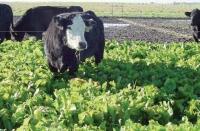Forage of the Month: Brassicas
By Dr. Michelle Arnold, Extension Ruminant Veterinarian
 Brassicas (including turnips, rape, kale, and swedes) are highly productive, digestible forbs that contain relatively high levels of crude protein. Animals will readily consume the tops and will also grub the root bulbs out of the ground. Dry matter yield depends upon soil type, fertility, time of seeding, and precipitation.
Brassicas (including turnips, rape, kale, and swedes) are highly productive, digestible forbs that contain relatively high levels of crude protein. Animals will readily consume the tops and will also grub the root bulbs out of the ground. Dry matter yield depends upon soil type, fertility, time of seeding, and precipitation.
Brassicas should not comprise more than about two-thirds of cattle diets because of their low dry matter and low fiber content. Therefore, it is important to provide adjacent pasture, corn stalks, or a palatable dry hay fed free choice to cattle when grazing these crops to decrease the incidence of diarrhea. It is also desirable to introduce cattle to brassicas slowly by limiting grazing for a few hours per day until their digestive systems are accustomed to them.
Brassica crops can cause animal health disorders if not grazed properly. Most brassica related disorders in cattle tend to occur during the first two weeks of grazing. The main disorders are polioencephalomalcia, hemolytic anemia (mainly with kale), and pulmonary emphysema. Other possible clinical disorders include nitrate poisoning, bloat, and metabolic problems such as goiter and hypothyroidism. Glucosinates present in brassicas are also precursors of irritants that can cause colic and diarrhea. Large bulbs may also cause choke. Certain brassicas (rape) can cause sunburn (scald) on light-skinned animals, especially if it is grazed while the plants are immature. Other potential problems include oxalate poisoning, and also taint of meat and milk. The following is a brief description of the main disorders.
Polioencephalomalacia (PEM) is a brain disorder characterized by blindness, aimless wandering, lack of coordination, and twitching of ears, eyes, and skin, which may develop in some cattle after a week or more of eating brassicas (usually turnip forages). Other clinical signs may include circling and convulsions. This disorder is thought to be related to the sulfur content of the plants, and can be exacerbated if the diet includes other high-sulfur feeds or high-sulfur water. However, brassicas can cause PEM by other as yet unknown mechanisms as well. Thiamine can be given as a treatment, but animals often do not respond.
A diet of pure brassicas can cause livestock to develop hemolytic anemia. The amino acid compound S-methyl-L-cysteine sulfoxide (SMCO) which accumulates in the plants is unique to this family of forage crops. In the rumen SMCO is converted to dimethyl disulfide that oxidizes hemoglobin. The defective hemoglobin is detected in the red blood cells that are then removed by the spleen. Hemolysis (rupture of the red blood cell) also occurs as a result of the oxidative damage to the red blood cell membrane that results in hemoglobinuria (red urine). The severity is greatest in cattle fed kale, rape and turnips. Cattle become progressively weaker and may die from severe anemia unless removed from the plants. Hemolytic anemia is characterized by red urine, pale mucous membranes, and unthrifty appearance. Some animals may collapse and suddenly die.
Cattle given sudden access to turnip fields following relatively dry, high roughage diets may develop acute respiratory distress syndrome. Pulmonary emphysema causes rapid, difficult breathing accompanied by a grunt on expiration. Affected animals stand with extended heads, dilated nostrils, and open mouths with protruding tongues. Death may occur within two days. Surviving animals have a slow recovery over several weeks. Green turnip tops are a rich source of tryptophan that is converted in the rumen to 3-methyl indole which ultimately damages the lungs. The toxicity of the turnip tops is markedly reduced after they have been frozen.
Brassicas can cause a variety of other problems as well. Nitrate poisoning has been documented from excessive nitrogen fertilization. Accumulation of calcium and potassium can reduce the availability of magnesium to animals, resulting in hypomagnesemia or "grass tetany." Bloat can also occur when grazing rape or turnips. All brassicas but especially turnips contain glucosinolates, which are chemicals that prevent the uptake of iodine by the thyroid gland, resulting in hypothyroidism and goiter. Goiter can occur in all animals grazing brassicas, but is more of a concern with sheep and goats. Brassicas can contain large amounts of oxalate, causing oxalate poisoning and subsequent kidney failure.
Some people are genetic “tasters” and can easily taste the bitter phenylthiocarbamide (PTC) chemical in brassicas, while to others it is virtually tasteless. The ability to taste PTC is a dominant genetic trait in humans. Producers should take this into consideration if using on dairy animals or fattening grass-fed feeder animals. It is important to graze brassicas after milking to avoid milk taint.
Categories:
Winter
Forage Related Disorders


